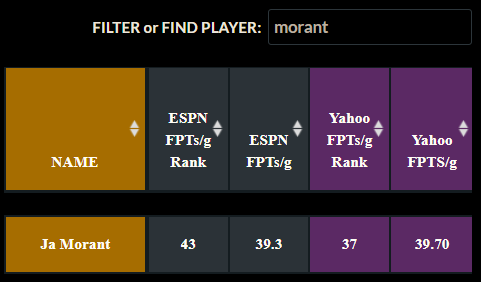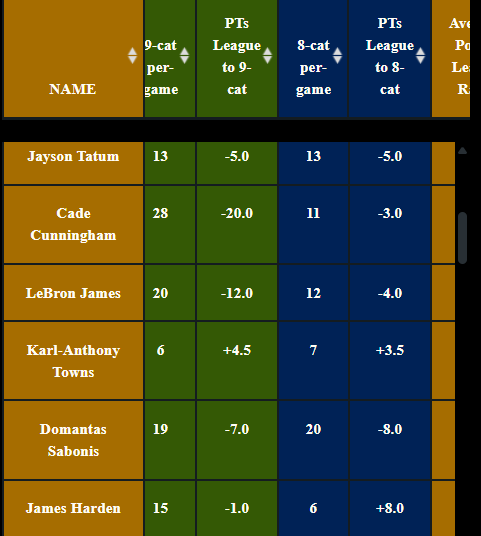-
 August 19, 2025, 7:51 pm
August 19, 2025, 7:51 pmLast Updated on October 5, 2025 6:33 pm by Aaron Bruski | Published: August 19, 2025
I first did this as part of our 2024-25 Draft Guide as a bit of a passion project and I am back again. I started playing fantasy basketball in an ESPN Points League and it was a few years before I tested out 9-cat and eventually embraced the format. Switching to category formats can be daunting, but the challenge of building a cohesive unit to compete in nine separate stats can be quite fun and riveting.
For any managers out there looking to follow a similar journey to mine, I am here to help you.
What Are The Main Types of Category Leagues?
First of all, there are Head-to-Head (H2H) category leagues and Rotisserie (Roto) leagues. Leagues are also commonly split into either nine categories (9-cat) or eight categories (8-cat). Let us delve into the specifics.
9-cat leagues vs. 8-cat leagues
The default nine categories are:
- Points
- 3PM
- Rebounds
- Assists
- Steals
- Blocks
- FG%
- FT%
- Turnovers
Hence it is referred to as a 9-cat league. However, for some, the inclusion of turnovers is considered controversial or unnecessary and some (many?) managers ignore it altogether even in 9-cat formats.
In some cases, a fantasy commissioner may choose to exclude that category, therefore creating an 8-cat (or 8-category) league instead.
Head-to-Head (H2H) Category Leagues
This format will resemble your points league format, as it involves weekly matchups between the managers in the league.
In a typical 9-cat league, the threshold for winning a week is by having better production in at least five categories than your opponent. That would equate to a 5-4 victory. In 8-cat, you can tie a matchup 4-4, so getting five categories under your belt is still the threshold for a victory at 5-3.
Most leagues follow the “H2H Each Win” system where your weekly matchup score is added to the standings. That is, if you win 5-4, you have a 5-4 record added to the standings. If you win 7-2, you have a 7-2 record added to the standings.
Some leagues, albeit rarely, will have a “H2H Most Wins” system where the matchup winner has only one win added to the standings, while the matchup loser has one loss added to the standings, just like a points league table. Essentially, that means winning 5-4 or 7-2 doesn’t matter too much, because a win is just a win (and a loss is just a loss) either way.
There are some nuances, as when you think about it, a team that rattles off a lot of 7-2 or 6-3 victories is more likely to climb to the top of the standings in H2H Each Win. However, a team that wins 6-3 or 5-4 every week could feasibly have the same record as that “7-2, 6-3 team” in H2H Most Wins. Personally, I would say the default way of adding the full matchup score to the standings makes more sense to clearly distinguish between the levels of the teams. Losing 4-5 isn’t as bad as losing 2-7 or 1-8, and I like that the default Each Win setting accounts for that.
Read our H2H Strategy Guide here!
Rotisserie (Roto) Leagues
This format is a battle of attrition. It is a season-long league that rewards consistent planning and production across the 25 weeks of the NBA regular season.You want to beat your opponents in as many categories as possible once again, but the only result that matters is when all 82 games have been played.
Let’s say your league has eight managers (for simplicity’s sake) and the typical nine categories.
If your fantasy team is first in assists, you will be rewarded with eight roto points (the same as the number of teams in your league). The team with the second-most assists will receive seven roto points and so on. Therefore, the team with the least assists will only receive one roto point. In an 8-team 9-cat roto league, you can hypothetically earn up to 72 roto points (8 managers multipled by 9 categories). Or, if you manage to be last in all nine categories, you would have eight roto points.
There are more intricacies like positional game caps, but you should read our Roto Strategy Guide to learn more.
Read our Roto Strategy Guide here!
Strategic Differences Between Points Leagues and Category Leagues
We are getting into the nitty-gritty soon, but I want to throw in this preview of the table I included at the end of this article. It will make a lot of context into the things I am about to dive into, and after you have that, you can better observe for yourself how players’ rankings (or values) change when you shift from a points format to a category format.
Keep in mind that Yahoo’s Points League system does not punish inefficiency and has a slightly higher reward for rebounds.
ESPN’s Points League system rewards efficiency, defensive stats and assists with a higher punishment for turnovers.


Matchup Data Collection and Presentation
Want to gain more knowledge for your transition from Points Leagues to Category Leagues? You’ll need to have an NBA FantasyPass membership or purchase the Draft Guide. Click here to learn more and sign up!
Premium Access Required
📢 Want More? 📢
🏠 Go to the Draft Guide Home Page Here
 Join our Discord: Click Here to Join!
Join our Discord: Click Here to Join!📡 Download the SportsEthos App to get real-time alerts and updates:
Get the SportsEthos App (iOS App Store) Get the SportsEthos App (Google Play)
 Follow us on Twitter: @EthosFantasyNBA
Follow us on Twitter: @EthosFantasyNBA🏆 Join our premium community built on integrity, competition, and winning. Let’s crush this season together.
Get the NBA FantasyPass!Join the SportsEthos team! Fill out an application by clicking here!

